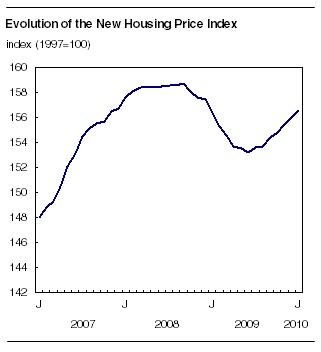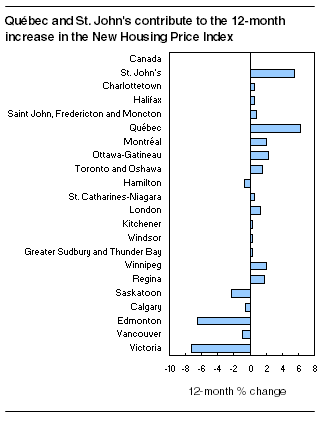Common menu bar links
New Housing Price Index
Archived Content
Information identified as archived is provided for reference, research or recordkeeping purposes. It is not subject to the Government of Canada Web Standards and has not been altered or updated since it was archived. Please "contact us" to request a format other than those available.
Related subjects
The New Housing Price Index rose 0.4% in January, registering the same month-over-month growth rate for the third consecutive month.

Between December and January, prices rose the most in St. John's (+1.7%), followed by Winnipeg (+0.7%), and Toronto and Oshawa (+0.6%). Ottawa–Gatineau, Saskatoon and Calgary all registered 0.5% increases.
In St. John's, prices rose as builders reported new 2010 list prices as well as increased labour costs. In Winnipeg and in Toronto and Oshawa, the increase in prices was primarily attributed to higher list prices introduced in the new year.
Builders in Ottawa–Gatineau as well as in Toronto and Oshawa continued reporting good market conditions.
The largest monthly decrease in new housing prices was recorded in St. Catharines–Niagara (-0.4%). Monthly declines were also observed in Charlottetown (-0.2%) as well as in Saint John, Fredericton and Moncton (-0.2%). Lower negotiated selling prices reported by builders mostly explain the decreases in prices in January.
Year over year, the New Housing Price Index was up 0.1% in January, compared with a 0.9% decline in December 2009. This was the first year-over-year increase since December 2008, mostly as a result of price decreases in Western Canada that were less pronounced this January than in previous months.

The largest year-over-year increase was recorded in Québec (+6.2%) followed by St. John's (+5.5%). Higher residential land values remain the primary reason for the increases in both metropolitan areas.
Compared with January 2009, contractors' selling prices were also higher in Ottawa–Gatineau, Winnipeg, Montréal, Regina as well as Toronto and Oshawa.
On the Prairies, 12-month declines were recorded in Edmonton (-6.5%), Saskatoon (-2.3%) and Calgary (-0.6%).
Year-over-year declines were also reported in Victoria (-7.3%) and Vancouver (-1.0%).
Declines slowed in most of Western Canada's metropolitan regions as new housing prices were returning to the price levels observed prior to the highs registered at the end of 2007 and the beginning of 2008.
Available on CANSIM: table 327-0005.
Definitions, data sources and methods: survey number 2310.
The fourth quarter 2009 issue of Capital Expenditure Price Statistics (62-007-X, free) will be available in April.
For more information, or to enquire about the concepts, methods or data quality of this release, contact Client Services (613-951-4550; toll-free 1-888-951-4550; fax: 613-951-3117; ppd-info-dpp@statcan.gc.ca), Producer Prices Division.
Table 1
| 2010 | January 2009 | December 2009 | January 2010 | December 2009 to January 2010 | January 2009 to January 2010 | |
|---|---|---|---|---|---|---|
| Relative Importance1 | (1997=100) | % change | ||||
| Canada total | 100.00 | 156.4 | 156.0 | 156.6 | 0.4 | 0.1 |
| House only | ... | 164.4 | 164.9 | 165.8 | 0.5 | 0.9 |
| Land only | ... | 140.2 | 137.8 | 137.9 | 0.1 | -1.6 |
| St. John's | 1.20 | 179.1 | 185.7 | 188.9 | 1.7 | 5.5 |
| Charlottetown | 0.31 | 119.6 | 120.4 | 120.2 | -0.2 | 0.5 |
| Halifax | 1.22 | 150.4 | 151.1 | 151.3 | 0.1 | 0.6 |
| Saint John, Fredericton and Moncton2 | 0.88 | 119.9 | 121.1 | 120.9 | -0.2 | 0.8 |
| Québec | 2.46 | 160.4 | 170.4 | 170.4 | 0.0 | 6.2 |
| Montréal | 10.11 | 163.9 | 167.1 | 167.2 | 0.1 | 2.0 |
| Ottawa–Gatineau | 4.71 | 169.6 | 172.7 | 173.5 | 0.5 | 2.3 |
| Toronto and Oshawa2 | 33.99 | 146.5 | 148.0 | 148.9 | 0.6 | 1.6 |
| Hamilton | 2.96 | 152.3 | 151.0 | 151.3 | 0.2 | -0.7 |
| St. Catharines–Niagara | 0.96 | 155.9 | 157.4 | 156.8 | -0.4 | 0.6 |
| London | 1.91 | 143.3 | 145.1 | 145.1 | 0.0 | 1.3 |
| Kitchener | 2.17 | 143.2 | 143.8 | 143.7 | -0.1 | 0.3 |
| Windsor | 0.65 | 103.7 | 104.0 | 104.0 | 0.0 | 0.3 |
| Greater Sudbury and Thunder Bay2 | 0.85 | 112.7 | 112.6 | 113.0 | 0.4 | 0.3 |
| Winnipeg | 1.62 | 181.4 | 184.1 | 185.3 | 0.7 | 2.1 |
| Regina | 0.59 | 248.7 | 253.1 | 253.1 | 0.0 | 1.8 |
| Saskatoon | 0.81 | 219.8 | 213.7 | 214.8 | 0.5 | -2.3 |
| Calgary | 7.88 | 235.7 | 233.2 | 234.4 | 0.5 | -0.6 |
| Edmonton | 8.29 | 222.3 | 207.3 | 207.9 | 0.3 | -6.5 |
| Vancouver | 14.39 | 119.7 | 118.0 | 118.5 | 0.4 | -1.0 |
| Victoria | 2.04 | 114.3 | 106.1 | 106.0 | -0.1 | -7.3 |

